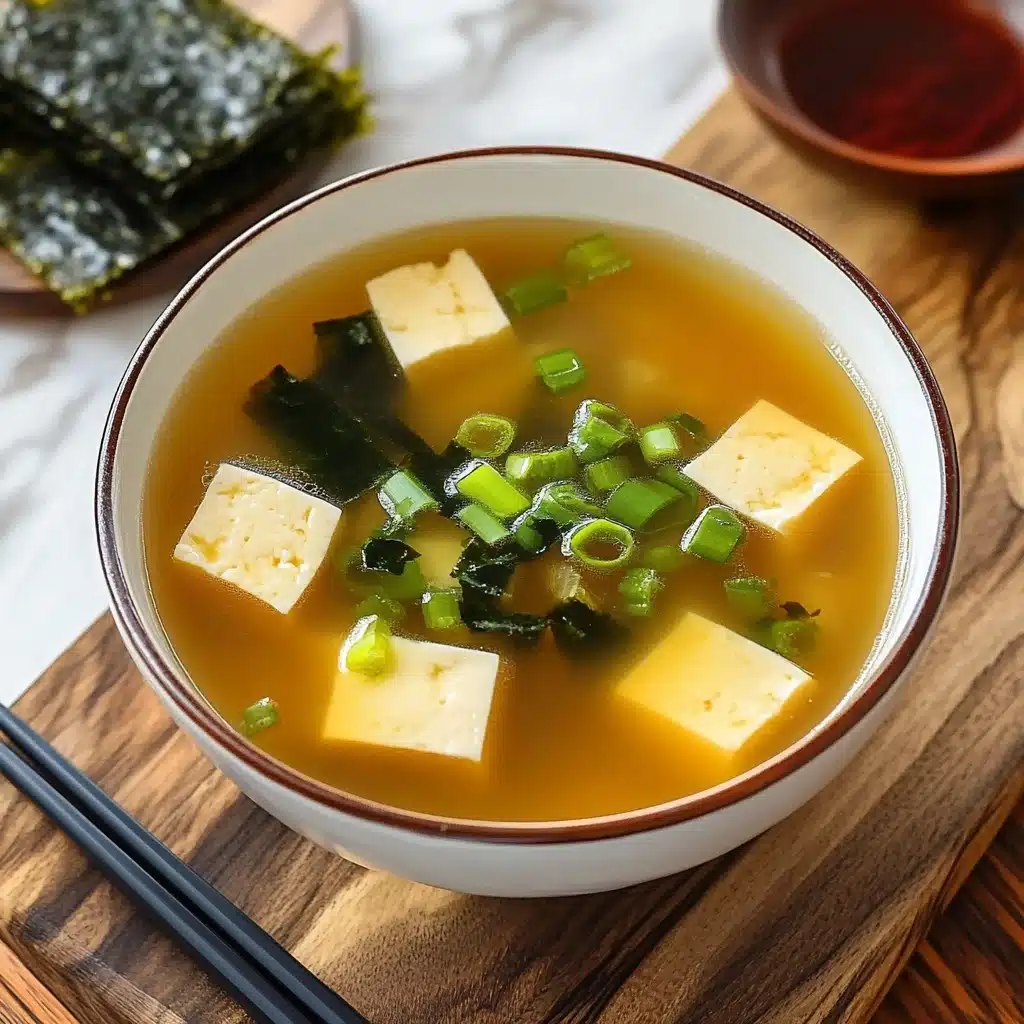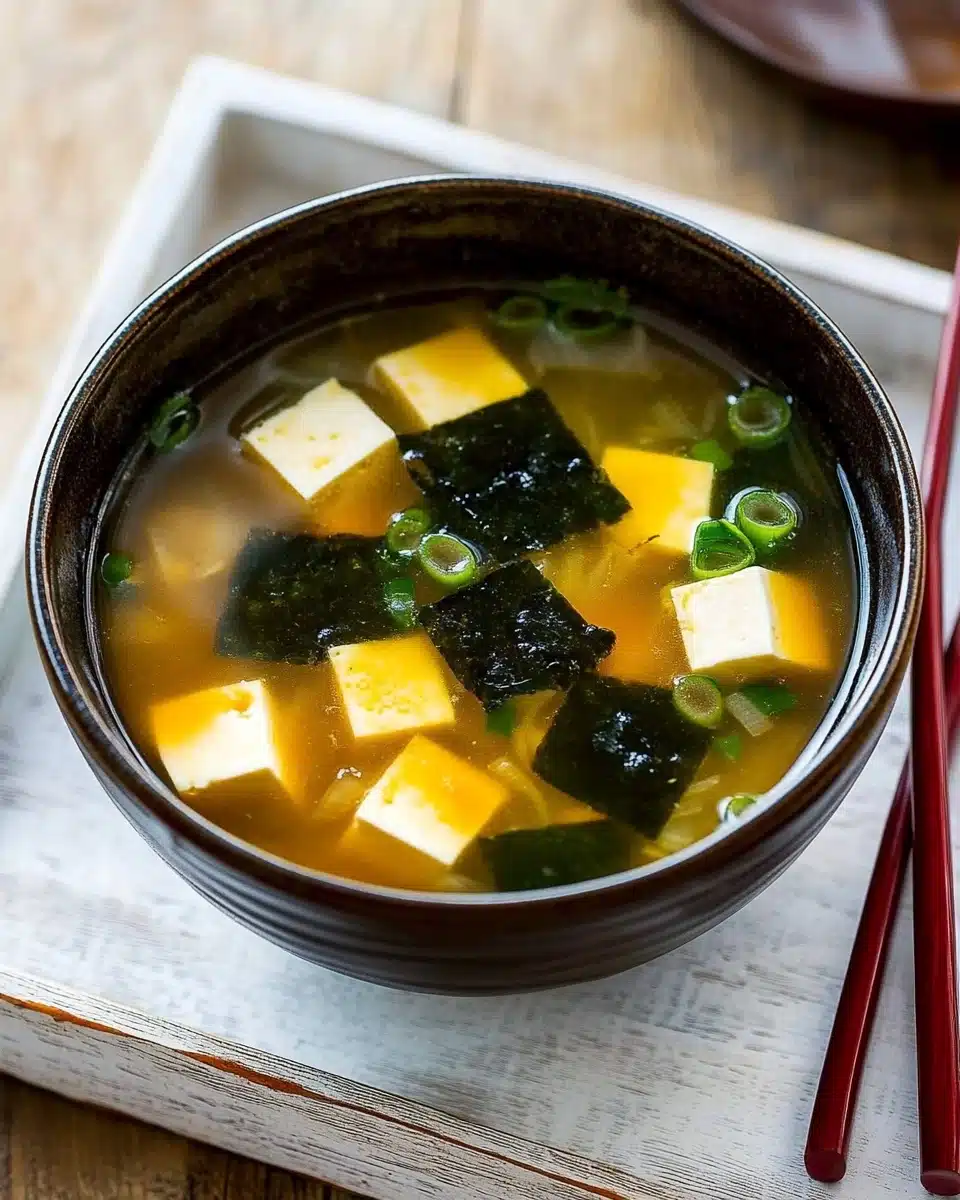Savor the comfort and pure umami of Homemade Miso Soup with Tofu—a delicate, nourishing bowl you can create in just minutes right in your own kitchen. This authentic Japanese classic delivers sweet, salty depth with silky tofu and wakame swimming in a dashi-rich broth that soothes at every sip!
Why You’ll Love This Recipe
- Restaurant-Quality Broth: Homemade Miso Soup with Tofu is all about that magical dashi base—your kitchen will smell like the best Japanese restaurant!
- Genuinely Nourishing: This soup is loaded with protein from silky tofu, minerals from seaweed, and probiotics from miso, making it as good for your body as it is for your soul.
- Quick and Simple: Ready in just 20 minutes, it’s the easiest way to add warmth and comfort to any meal—even on the busiest weekday.
- Customizable for Everyone: Easily adapt for vegan diets or ramp up flavors with different toppings, so every bowl is uniquely yours.

Ingredients You’ll Need
There’s nothing fussy here—just classic Japanese staples that are each fundamental to the classic flavor, texture, and color of Homemade Miso Soup with Tofu. Every ingredient plays a starring role, so gather the freshest you can find!
- Kombu (dried kelp): Lends the dashi broth its signature oceanic depth and gentle sweetness—don’t scrub off that white coating; that’s pure umami!
- Katsuobushi (dried bonito flakes): These smoky flakes create an aromatic and richly savory foundation for a comforting, authentic soup.
- Soft/silken tofu (kinugoshi dofu): Adds a pillowy, delicate texture and soaks up all that umami—silken tofu is the gold standard here!
- Miso paste: The soul of the soup! White, red, or awase (mixed) work—choose your favorite for flavor and adjust saltiness.
- Dried wakame seaweed: Brings both visual appeal (that gorgeous green ribbon!) and trace minerals for nutrition.
- Green onion/scallion: Adds a crisp, peppery brightness right at the end—don’t skip this, it ties everything together.
- Water: The base for your homemade dashi; filtered water works best to keep flavors clean and clear.
Variations
One of the best things about Homemade Miso Soup with Tofu is how adaptable it is. Use whatever you have on hand, adjust to suit your dietary needs, or tweak ingredients to match your favorite flavors—this soup welcomes experimentation!
- Vegan Version: Make dashi with only kombu (or add dried shiitake mushrooms) for a savory, plant-based base, omitting the bonito flakes entirely.
- Add Mushrooms: Toss in a handful of sliced shiitake, enoki, or cremini mushrooms for even more texture and earthy goodness.
- Mix Up the Miso: Play around with white (shiro), red (aka), or mixed (awase) miso for subtle differences in taste and color.
- More Toppings: Try thinly sliced radish, baby spinach, or even a sprinkle of sesame seeds to make every bowl a little different.
How to Make Homemade Miso Soup with Tofu
Step 1: Make Your Kombu Dashi
Start by placing your kombu in a pot with cold water. For the very best umami, let it soak for at least 30 minutes—even overnight in the fridge is wonderful if you have time! Heat slowly (never boiling) and remove the kombu just before the water reaches a simmer to avoid bitterness and sliminess. This is your beautiful Kombu Dashi, already brimming with gentle, savory notes.
Step 2: Add Katsuobushi for Awase Dashi
For a classic Japanese flavor (unless you’re making a vegan version), sprinkle in the katsuobushi flakes while the kombu dashi is hot. Let it just come to a gentle simmer, then turn off the heat and allow the flakes to settle—about 10 minutes. Strain with a fine-mesh sieve; now you have fragrant, golden Awase Dashi, ready for soup magic!
Step 3: Prepare Tofu and Green Onion
While your dashi cools slightly, cut the soft tofu into bite-sized cubes and thinly slice the green onion. Be gentle with the tofu—using a sharp knife and even slicing on your palm (carefully!) is a satisfying, traditional touch.
Step 4: Dissolve the Miso Paste
Pour the hot dashi back into your saucepan if needed and keep over low (not boiling!) heat. Place the miso paste in a ladle or strainer and gradually whisk in hot dashi to dissolve. Stir it into the soup until smooth and fragrant—never add miso to a rolling boil, or you’ll lose those subtle aromas and nutrients.
Step 5: Add Tofu, Wakame, and Green Onion
Slip the cubed tofu gently into the miso broth, followed by dried wakame and your green onion. Stir gently to distribute (but don’t break up the tofu!). Heat just until everything is warmed through and the wakame is rehydrated—your Homemade Miso Soup with Tofu is ready to serve, vibrantly green and inviting.
Pro Tips for Making Homemade Miso Soup with Tofu
- Extract the Most Umami from Kombu: Always soak kombu before heating; a longer soak brings out richer, more complex flavors and absolutely no bitterness.
- Never Boil the Miso: Add miso off the heat or at the lowest simmer—boiling destroys both the delicate fermented flavor and beneficial probiotics.
- Gentle Handling for Tofu: Add tofu last and move it gently—soft tofu is fragile and deserves a delicate touch for perfectly intact cubes in every bowl.
- Wakame Rehydration Option: Rehydrate dried wakame in a separate bowl if you want to control saltiness, especially if you’re aiming for a lower sodium soup.
How to Serve Homemade Miso Soup with Tofu

Garnishes
The finishing touches matter—thinly sliced green onions add a crisp pop of color and flavor. For extra flair, try snipped chives, a dusting of toasted sesame seeds, or even a tiny swirl of chili oil for subtle heat. A few drops of yuzu juice or grated ginger can make every bowl bright and lively.
Side Dishes
Homemade Miso Soup with Tofu shines as a starter for a Japanese meal, pairing beautifully with steamed rice, grilled salmon, a simple cucumber salad, or crisp vegetable tempura. It’s lovely with pickled vegetables or a quick tamagoyaki (Japanese omelette) for any quick lunch spread.
Creative Ways to Present
For a stunning presentation, ladle your soup into small lacquered bowls for a classic touch. Try mini tasting cups for a party appetizer, or add edible flower petals, microgreens, or gold leaf for an elegant twist at a special gathering—the colors and textures will delight every guest!
Make Ahead and Storage
Storing Leftovers
Miso soup tastes best fresh, but you can refrigerate cooled leftovers in an airtight container for up to 2 days. If possible, store the soup and tofu separately to keep the tofu’s texture soft and delicate.
Freezing
You can freeze the dashi broth on its own for up to 2 weeks. If you want to freeze miso soup, remove the tofu first as freezing changes its texture—then defrost only what you’ll use and add fresh tofu when reheating.
Reheating
Gently reheat Homemade Miso Soup with Tofu on the stovetop over medium-low heat; never boil, or you’ll lose flavor. Add a fresh spoonful of miso paste at the end if you want to boost the broth’s aroma and taste!
FAQs
-
Can I use instant dashi powder for Homemade Miso Soup with Tofu?
Absolutely! While homemade dashi gives the deepest flavor, an instant dashi powder is a great shortcut on busy days. Adjust the quantity to taste, and keep an eye on saltiness as some powders are quite seasoned.
-
What type of miso works best?
White miso (shiro) is gentle and sweet, while red (aka) miso is bolder and saltier. Awase miso (a blend) is a lovely balance. Feel free to use what you enjoy most, but start with less and taste before adding more.
-
Can I make Homemade Miso Soup with Tofu gluten-free or vegan?
Yes! For gluten-free, double-check your miso paste label. For vegan, use only kombu and dried shiitake mushroom for your dashi base and skip the bonito flakes.
-
Is it possible to add extra protein or veggies?
Definitely—add sliced mushrooms, spinach, thin carrot ribbons, or even edamame for variety and nutrition. The soft tofu is classic, but don’t be afraid to experiment to make this Homemade Miso Soup with Tofu your own!
Final Thoughts
I always come back to Homemade Miso Soup with Tofu whenever I need a little nourishing comfort—it’s cozy yet uplifting, easy yet so rewarding. I hope you love making (and slurping!) this classic as much as I do. Give it a try, and let every bowlful wrap you up in pure umami bliss!
Print
Homemade Miso Soup with Tofu Recipe
- Prep Time: 5 minutes
- Cook Time: 15 minutes
- Total Time: 20 minutes
- Yield: 4 servings
- Category: Soup
- Method: Stovetop
- Cuisine: Japanese
- Diet: Vegetarian
Description
Learn how to make flavorful and comforting Homemade Miso Soup with Tofu at home, using simple ingredients and traditional Japanese cooking techniques.
Ingredients
For the Dashi:
- 4 cups water
- 1 piece kombu (dried kelp) (1/3 oz, 10 g per piece; 4 x 4 inches or 10 x 10 cm)
- 1 cup katsuobushi (dried bonito flakes) (packed; I used a loosely packed 3 cups in the video for stronger flavor)
For the Miso Soup:
- 7 oz soft/silken tofu (kinugoshi dofu)
- 4 Tbsp miso (use 1 Tbsp, 18 g for every 1 cup, 240 ml of dashi)
- 1 Tbsp dried wakame seaweed
- 1 green onion/scallion
Instructions
- Dashi 3 Ways – Gather all the ingredients.
- Miso Soup Ingredients – Cut 1 green onion/scallion into thin rounds.
- To Make the Dashi (can make in advance) – Add 4 cups water and 1 piece kombu to a medium saucepan…
Notes
- If using dashi from the refrigerator, bring it to a slow boil before adding the miso.
- Rehydrate dried wakame in a separate bowl of water to reduce saltiness.
Nutrition
- Serving Size: 1 cup
- Calories: 57 kcal
- Sugar: 2 g
- Sodium: 532 mg
- Fat: 2 g
- Saturated Fat: 0.3 g
- Unsaturated Fat: 1 g
- Trans Fat: 0 g
- Carbohydrates: 5 g
- Fiber: 1 g
- Protein: 4 g
- Cholesterol: 0 mg








